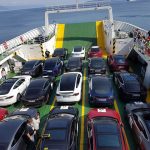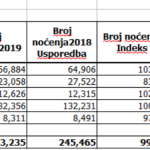As the Croatian coast ‘enjoys’ a record tourism summer, has the current tourism capacity of the coast reached its peak? A look at the pressure points – and the alternatives – to the current tourism strategy on July 14, 2017.
Reporting on tourism in Croatia sometimes feels like reporting on Stalin and the Five Year Plan.
In this five year plan, we produced five billion tonnes of steel, up 234% from the last plan from 1928 – 1933.
And there seem to be similarities when officials report on Croatian tourism. Last year was a record year, with 91 million overnights, some 10 million up on 2015, and 2017 is breaking all records. The first six months of 2017 brought 5.7 million tourists and 22.9 million overnight stays, this before peak season has started. This was a rise of 22% and 23% respectively on the previous year, itself a record. Just yesterday, it was announced that the city of Split is up an astonishing 31% in the first half of the year, and its airport (new terminal not due until 2019) is up a staggering 25.4% on last year’s record breaker.
These are all big numbers, and very welcome to the state coffers, especially in Croatia, whose GDP includes 18% from tourism, the second highest in Europe after Malta. And with the problems facing its biggest company, Agrokor (which is the equivalent of 15% of its GDP), a bumper tourist season is of critical importance. So far so good.
The next six weeks are the true peak of the season, a time when yet more new flights will touch down, yet more tourists appear on the Adriatic’s fine beaches, watching numerous cruise ships along the Adriatic taking their passengers to the historic ports of Split and Dubrovnik, with sometimes over 10,000 cruise passengers a day descending on the towns, which are already full of regular guests.
There comes a point when it is not possible to squeeze more tourists in, and there comes a point (already reached in certain quarters) where the existing infrastructure cannot cope with the surge in tourist demand. And in the rush to attract more tourists (for which congratulations to those responsible, the increase is genuinely impressive), little attention has been paid to the quality of both the incoming tourist, and also the quality of the tourism experience they encounter on arrival.
This is not a rant complaining about peak season tourism – far from it, I recognise that Croatia needs as much tourism as it can get (and it has certainly benefited from unfortunate events in Egypt, Greece and Turkey in recent years) – it is more an overview of where the issues are, and more interestingly, where the opportunities for growth elsewhere exist, and are not yet being exploited.
It is not just the media who have noticed the surge in numbers. UNESCO has expressed concern at the impact of mass tourism on three of its World Heritage Sites, Dubrovnik, Diocletian’s Palace in Split and the majestic Plitvice Lakes. New Dubrovnik Mayor Mato Frankovic has already started discussions on how to reduce congestion in the old town of Dubrovnik, with the ultimate aim of having a maximum of 4,000 cruise ship visitors in the old town at any one time. His predecessor announced plans to limit the number of people entering the old town at any one moment to 8,000, so the authorities are certainly aware of the problem.
The problem is that they do not have complete control of the situation, including how many cruisers come into the city. This is done by the Port Authority, and until recently the Port of Dubrovnik was up for concession, meaning any successful bidder would have been able to bring in as many cruise ships as they could handle, with the main goal in business being profit, not how many people were filling up the city. Split seems to be going down the same route, managing to cram in 10,000 cruise passengers in one day. The numbers are great, and Stalin would have been impressed. The long-term damage to tourism was excellently portrayed recently by The Daily Telegraph in its piece, The Death of Dubrovnik.
Ironically, Croatia might be spared from cruise excess by an unlikely ally, and one which has had a significant impact on its coastal history – Venice. Local objections to the incessant cruise ship traffic in the Italian hotspot has led to a 10% reduction in arriving ships. With Venice the star attraction on the Adriatic, some cruise companies are switching their Adriatic cruises for other parts of the globe, a move which should mean a reduction in cruise ship arrivals in Croatia this year. I personally have never understood the merits of cruise ship tourism for destinations which are successful in their own right, such as Venice and Dubrovnik. The invasion of cruise hordes does wonders for data for the Five Year Plan, for sure, but with minimal spend and maximum disruption, they are keeping high-spending tourists from visiting the city, staying in the hotels and eating in the restaurants. (The best time to visit Dubrovnik? Without a doubt, the first week of February, for the Festival of St. Blaise. Here is why.)
The other issue which is just starting to rear its ugly head in places like Novalja and Hvar Town, but soon elsewhere, is the friction caused by party tourism, and while the signs the Mayor of Hvar Town installed to fine inappropriate behaviour and dress went global, less is being written about the potential damage which Croatian tourism could experience en masse, unless some thought and strategy is put in place.
Croatia is undoubtedly a cool destination, and the rise in British tourists in particular has been marked in recent years, aided considerably by a huge increase in budget flight options from all corners of the UK. The branding of Croatia as a cool festival destination, home to major events such as Ultra Europe, has helped sell Croatia to a new generation of tourist. Good for this Five Year Plan, and extremely good for the next two or three as well. So far so good.
One of the things long-time visitors to Croatia tell me that they particularly love about coming is that it is not like Spain, and one doesn’t find he hordes or marauding (ok, moronic) drunken Brits at every turn. Is this about to change? And if it is, it would change very quickly, and Croatia would struggle to cope with the invasion of Magaluf veterans in search of a new destinaton to ‘explore’. And those Magaluf drunks and low level tourists ARE looking further afield, especially now that the town authorities have introduced 64 rules for the summer – imagine being asked to pay a fine for having sex in the street. And even more interestingly, those rules seemed to get much less global media attention than the Hvar Town mayor’s not unreasonable wish that people didn’t drink on the streets in the town’s historic town centre and be dressed appropriately.
I have followed the international media reaction to the Hvar Town signs very closely, and it seems that what TCN writes is watched even more closely. I took The New York Times to meet the Hvar Town Mayor, Riki Novak, recently, and where he gave very in-depth explanations of his plans, which you can read here. The Times of London was the latest paper to call today, and the story has been widely discussed all over the globe, with two very different reactions. I would say that overall the move has been mostly welcomed, especially among higher quality tourists, who seem encouraged that a quality destination has decided to make a stand. And then there is the other reaction, as portrayed to your average Magaluf reader, by our friends at The Daily Star – see below.
Would Hvar Town survive the loss of such quality tourism in the long term? The Five Year Planners would probably be sent to the gulag for a short-term drop in numbers, but thankfully we are not living in the Stalinist Soviet Union. Hvar Town’s mayor was at pains to point out two things when we met – that party tourism is more than welcome on Hvar, and has a very long tradition (the oldest disco club in former Yugoslavia opened on Hvar in 1964). And secondly, the island has a long tradition of quality tourism, a history which will be celebrated next year with the 150th birthday of organised tourism in Europe, a story which started out with a hotel in Hvar Town which today sits opposite the oldest public theatre in Europe. Perhaps not the best location for the new Magaluf?
The Daily Star’s article also contains these words, which I will just leave out there – Croatia, you have been warned. There is a fine line between a cool festival destination, and what the Spanish are now trying to offload elsewhere:
“Meanwhile, authorities in Magaluf, on the Spanish isle of Majorca, have also vowed to put an end to the “anything goes” culture of Brits abroad.
“Local authorities on the Spanish island recently resorted to banning all-inclusive holidays in Magaluf in an attempt to try and kerb British drunkenness.
“As a result of the crackdown in Maga, Brits are flocking to other European resorts in search of looser rules.”
All very well, I hear you cry, but the Croatian economy is so dependent on tourism that it has to tolerate the crowds and the bad behaviour to survive. Well yes, and no.
The reality is that there is no more room to pack more tourists into some of Croatia’s top sites, such as Dubrovnik, and it is interesting to see Krka National Park limiting its numbers at any one time to its prime attraction this year. In order to continue to grow tourism in Croatia, it will have to look elsewhere, namely inland and out of the peak season.
There have been several initiatives to develop tourism out of peak season, with some spectacular results in parts. This is nowhere more so than in the capital, where Advent in Zagreb went from a few stalls on the main square to the best Advent in Europe two years running. Apart from bringing the city to life at this quiet time of year, last year Zagreb had more tourists in December than many medium-sized coastal destinations manage in a year. From nothing. So growth outside the pressure points IS possible.
There are also encouraging signs elsewhere. There has been strong growth in tourism from Asia in recent years, a trend which was popularised by a South Korean reality show initially, but South Korea, China and Japan are all growing statistics on the Croatian tourism map. This growth has been helped by the introduction of daily flights via Doha from Qatar Airways, and the news that Emirates has been satisfied enough with its Zagreb launch on June 1 this year to continue the road from Dubai through the winter. Asian tourists tend to visit out of the peak season, when temperatures are cooler and the destinations less crowded. A stronger focus on these markets, and a strategy to have a little life in some of the coastal resorts in the winter and shoulder months to entertain these Asian tourists, and we could see a nice growth in tourism business for all.
Flights, flights, flights. The number of flights to Croatia has increased dramatically since Ryanair opened up the low-cost market a decade ago in Zadar, but it remains a fact that reaching Croatia in the winter is a challenge, and there are plenty of tourists who would be interested in a long weekend in Split, for example. Have you walked around the streets of Oslo in late November? Norwegian has become one of the strongest carriers in the Croatian market, and an intelligent partnership with them could easily see high-spending Scandinavians wanting to escape the never-ending winter for some winter sun, culture and great food just three hours away.
And speaking of food, one of the great untapped potentials of Croatian tourism – its gourmet offer. We hear so much about the 130 indigenous grape varieties, and yet Dalmatia does not even have a wine road. We hear so much about the rich regional foods, and yet there is no developed gastro tourism scene. Where are the gourmet tours of Croatia that are so prevalent in France, Italy and Spain? Gourmet tourists are high spending and not season dependent.
But back to those flights. I have a friend who runs a destination management company, offering some of the very best incentive trips on offer. He has clients all over the world who are desperate to hold their car launches, their product launches and their team building programmes in Croatia. He sells Croatia in two minutes to each and every one of them, until it comes to one small detail – flights. In season the hotels are too full, out of season, the flights are too complicated, and it is often cheaper for clients to take a package out of season in Dubai from the UK than coming to Croatia. Croatia has excellent conference facilities and a world class tourism offer once they arrive. Work with DMCs and the airlines, increase that accessibility, and the potential to grow Croatian tourism out of season is exciting indeed.
I am currently researching Croatian medical tourism for a big feature which will be published next week. I was astounded at the story so far, and how much is being achieved by private clinics offering state of the art medical care in a number of disciplines for a fraction of the cost elsewhere, and how much potential there is in for growth, especially in Zagreb, which is now enjoying greater continental and inter-continental connections. Again this is high-spending tourism which is not season-dependent, and the chance for someone to have medical treatment and a week’s holiday in Croatia is one which should be explored and supported. Much more on this in the medical tourism feature next week.
Continental Croatia is one of the untapped jewels of Croatian tourism, and one of the most underfunded. Support it! No planes are needed to arrive from Hungary, Slovenia, Austria or Southern Germany, and from agro-tourism, historic cities such as Varazdin, to those food and wine tours, the region has so much potential, as well as adding considerable value to the growing destination that is Zagreb.
A new Five Year Plan for Croatian tourism. The numbers will probably town in terms of tourism arrivals, and so Stalin would not be pleased, but the numbers in terms of revenue, and the tourism in terms of quality will certainly be up.
Maybe I am being too dramatic, but I do see that Croatia is at a crossroads with its tourism, and as I see an increase in the Magaluf wannabes, I hope that the country which reinvented itself after the war with the slogan, The Mediterranean as It Once Was will not soon be known as Spain as It Once Was.










